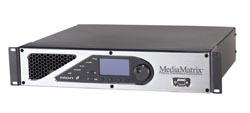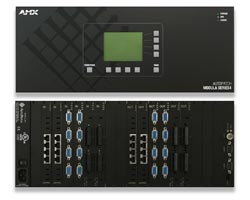Conventional Wisdom

- The convention center market is a niche that few contractors haven't been involved with in some respect, especially with the abundance of tradeshows that seem to be popping up every year. But now, with the advent of digital signage, convention centers are picking up where airports have been heading, displaying information on flat screens at every corner. Thus, contractors are putting more emphasis on audio and video distribution throughout these facilities.
- What do industry experts see as the key feature that these facilities require in their distribution systems? George Douglas, SPL's senior vice president believes it is versatility. "It's part of what you get now with everything becoming a networked device. Everything needs to be segmented and zoned because you don't know how big or how many shows will be going on at any given time. Versatility leads to complexity, but you can't have it seem that way to the customer or they'll never buy it, so it's a real task for the programmers and contractors because you have to make it all seem ultra simple."
- With versatility comes reliability, as Ron Camden, vice president of sales for Biamp noted. "There are a number of people using the equipment in convention centers, so something durable that can hold up to a number of untrained people is critical. The products need to be flexible and changing. The equipment has to be able to adjust to a number of different scenarios on the fly."
- Distributing audio and video over such distances can be a hassle, as Mike Andrews, director of marketing communications for Extron explained. "There are great distances involved in convention centers. Signals need to go to multiple destinations, and the need is for HD. Once you're trying to send those types of signals great distances, there's a lot more involved. You need the ability to share a lot of info with attendees, and there's so many people coming in that the centers are always split between different associations."
- Ron Baker, principle for Wrightson, Johnson, Haddon & Williams (WJHW), stressed the need for better access to technology in convention centers. "What we hear over and over again, is that clients want access to more technology. That doesn't mean that the gear is built in a permanent manner, but that the facility is capable of bringing it in for a specific event. So ultimately what that requires is an infrastructure to be present in the venue to accommodate the extensive flexibility and the requests they'll get."
- AMX's product manager, Paul Hand agreed, noting that the quality of the video is especially important for these facilities. "There should be an inherent desire for quality audio and video because it reflects on the quality level of the event center itself. People make concessions on that to hit a price point and end up with an inferior product. If you're willing to pay a little more you will realize the benefits of that. The ability to distribute content freely without being hindered by location issues is very important."
- Mark Pinske, general manager of MediaMatrix noted the importance of working with other technologies and brands to make these larger systems work. "You also have to be able to work with other brands, like our NION works with AMX and Crestron. You've got to bridge the gap with how your equipment works generically with theirs and incorporate their attributes into it. Product definition and product development give the consultants what they need, and their needs change everyday in a market like this."
- Life safety definitely comes into play a lot more now in this market, what with Europe's increasingly stringent requirements for voice evacuation. However, Baker discourages many clients against using similar systems. "We caution buildings in using sound reinforcement system as their primary evacuation system, partly because it requires a variance or some special permission from local authorities. There are a lot of authorities we've encountered that refused to consider such things, and insisted on a fully listed alarm system. In our case, even if we don't provide any augmentation, we still wind up trying to connect to that system so it will shut down audio at events to allow announcements to be read."
- Does the convention center market offer contractors a lot of opportunity? Baker thinks so. "Certainly from a contractor's point of view there is opportunity in convention centers. These can be large projects that can span an extended period of time. If you're a contractor pursuing the upper end of conference center facilities, you need to be aware of the technology that is being employed as we see multiple examples of convergence taking place. More and more things are network-centric, and there's more automation taking place. As more facilities try to distinguish themselves with specific abilities, this will be huge. There are a variety of opportunities for a diversified and trained contractor."
- Camden agreed, "Most of the convention centers that we're involved in are very busy, overbooked, and looking at expanding. The potential is excellent and people continue to go to tradeshows."
MediaMatrix NION
MediaMatrix is shipping the new NION, the next-generation MediaMatrix programmable digital audio processing node for professional and commercial audio and communications applications. The internal processing core of the NION, or networkable input output node, is supported by a wide range of features, including MediaMatrix's scalable I/O architecture, a modular I/O scheme that supports a variety of optional plug-in cards for maximum versatility. Four module bays support up to 32 simultaneous analog audio channels, while the integrated CobraNet port provides another 64 channels for a total of 96 simultaneous configurable audio channels. NION is built on a new embedded Linux architecture designed for stable, efficient, and robust performance.

AMX Modula CatPro Matrix Switcher
AMX's Modula CatPro matrix switcher distributes high-resolution computer video and stereo audio over any standard category cable. The ModulaCatPro matrix switching platform delivers the most intuitive skew compensation on the market, extremely high video quality, true stereo audio and customization options that allow local or long-distance inputs and outputs. Skew compensation occurs within the Modula CatPro to unify all inputs regardless of cable distance, which is critical to maintain picture quality when switching between signal paths of varying lengths. It also provides picture quality up to 1920 x 1080 at a full 1,000 feet, along with true two-channel stereo audio.

Biamp AudiaFLEX Digital Audio Platform
AudiaFLEX gives you control of your system with flexibility in design. Choose any configuration of input and output pairs to create the system you need. Multi-Channel audio can be distributed among multiple units via CobraNet, using Cat-5 cable. Control the processing power of the entire network over Ethernet, or via Crestron, AMX, or other popular controllers. Each AudiaFLEX can provide up to 24 channels of I/O, or expand your options even further with new AudiaEXPI and AudiaEXPO. AudiaFLEX is continuously being enhanced through hardware, firmware, and software upgrades such as CobraNet latency, feedback suppression, expanded transfer function, and other improvements.
AMX...www.amx.com
Biamp...www.biamp.com
Extron...www.extron.com
MediaMatrix...www.mediamatrix.peavey.com
A daily selection of the top stories for AV integrators, resellers and consultants. Sign up below.
